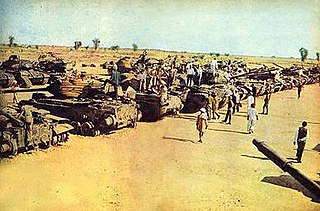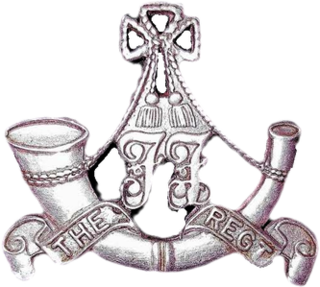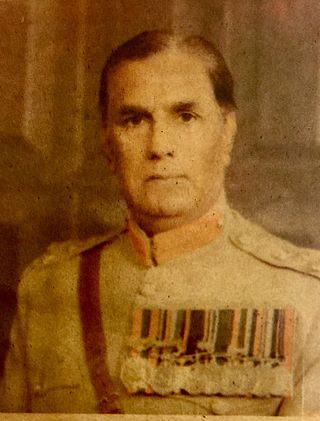
The Indo-Pakistani war of 1947–1948, also known as the first Kashmir war, was a war fought between India and Pakistan over the princely state of Jammu and Kashmir from 1947 to 1948. It was the first of four Indo-Pakistani wars between the two newly independent nations. Pakistan precipitated the war a few weeks after its independence by launching tribal lashkar (militias) from Waziristan, in an effort to capture Kashmir and to preempt the possibility of its ruler joining India.

Operation Grand Slam was a key military operation of the Indo-Pakistani War of 1965. It refers to a plan drawn up by the Pakistan Army in May 1965 that consisted of an attack on the vital Akhnoor Bridge in Jammu and Kashmir, India. The bridge was not only the lifeline of an entire infantry division of the Indian Army, but could also be used to threaten the city of Jammu, an important logistical point for Indian forces. The operation saw initial success, but was aborted when the Indian Army opened a new front in the Pakistani province of Punjab in order to relieve pressure in Kashmir. This forced Pakistan to abandon Grand Slam and fight in Punjab, thus the operation ended in failure and the stated objectives were not achieved.

The Battle of Asal Uttar was one of the largest tank battles fought during the Indo-Pakistani War of 1965. It was fought from 8 to 10 September 1965, when the Pakistan Army thrust its tanks and infantry into Indian territory, capturing the Indian town of Khemkaran 5 km from the International Border. The Indian troops retaliated, and after three days of bitter fighting, the battle ended with the Pakistani forces being repulsed near Asal Uttar. Factors that contributed to this were the fierce fight put up by the Indian Army, conditions of the plains, better Indian tactics, and a successful Indian strategy.

The Battle of Chawinda was a major engagement between Pakistan and India in the Second Kashmir War as part of the Sialkot campaign. It is well known as being one of the largest tank battles in history since the Battle of Kursk, which was fought between the Soviet Union and Nazi Germany in World War II.

Chumb is a city in the southern tip of Azad Kashmir, Pakistan. The Chumb sector consists of many villages, Kherowal, Burejal, Nagial, Paur, Dingawali, Chak Pandit, Praganwala, Jhanda, Singry, Sardari, Banian, Punjgran, all of these villages are located within Chhamb sector. People are from various ethnic groups such as Gujjars, Bakerwals, Paharis, Khokhars, and Mughals. A Baradari system is prevalent throughout the region.

Major General Iftikhar Khan JanjuaHJ & BAR SPk SQA of the Pakistan Army is one of the most senior Pakistani officers to have been killed in action. He is known in Pakistan as the hero of Rann of Kutch, as he was a brigadier in command of 6 Brigade, during the fighting in April 1965 prior to the Indo-Pakistani War of 1965. He was killed in a helicopter crash, in Kashmir, during the Battle of Chamb while in command of 23 Infantry Division during the Indo-Pakistan War of 1971. He is one of the only two Generals of Pakistan army to die in combat.

The Frontier Force Regiment is one of the six infantry regiments of the Pakistan Army. They are popularly known as the Piffers in reference to their military history as the PIF of the British Indian Army, or as the FF. The regiment takes its name from the historic North-West Frontier, a former province of British India and later Pakistan.

The 10th Indian Infantry Division was a war formed infantry division of the Indian Army during World War II. In four years, the division travelled over 4,000 miles (6,400 km) from Tehran to Trieste, fought three small wars, and fought two great campaigns: the Anglo-Iraqi War, the Invasion of Syria–Lebanon, the Anglo-Soviet invasion of Iran, the North African Campaign, and the Italian Campaign.

Dras, also known locally in Shina as Himababs, Hembabs, or Humas, is a town and hill station, near Kargil in the Kargil district of the union territory of Ladakh in India. It is on the NH 1 between Zoji La pass and Kargil. A tourist hub for its high-altitude trekking routes and tourist sites, it is often called "The Gateway to Ladakh". The government's official spelling of the town's name is "Drass".

Chalunka is a small mountainous village, in Nubra tehsil and Turtuk community development block, in Chorbat area of Shyok River valley in Ladakh, India. At the end of the Indo-Pakistani War of 1947, it was on the cease-fire line agreed between the India and Pakistan. After the Indo-Pakistani War of 1971, the village came under the jurisdiction of Indian-administered Jammu & Kashmir.

The Battle of Phillora was a large tank battle fought during the Indo-Pakistani War of 1965. It commenced on 10 September when the Indian 1st Armoured Division, with four armoured regiments and supporting forces under command, attacked positions in the Sialkot sector held by Pakistani 6th Armoured Division. After three days the Pakistanis withdrew with the loss of 66 tanks. The Indians admitted to the loss of 6 Centurions.

Brigadier Sher Jung Thapa MVC was a military officer of the Jammu and Kashmir State Forces and later the Indian Army. Revered as the Hero of Skardu, he was a recipient of the Indian Army's second highest gallantry award, the Maha Vir Chakra (MVC).

19th Battalion The Baloch Regiment is one of the oldest Light Anti-Tank Regiment of Pakistan Army. Initially raised as the Machine Gun Battalion of 10th Baluch Regiment in 1942, it was first designated as 53rd Regiment, Indian Armoured Corps and then re-designated as 17/10th Baluch. This unit has the unique honour of being the parent unit of Pakistan Army's special forces known as Special Service Group. Prominent officers including General Mirza Aslam Beg, General Pervez Musharraf have served in the unit and Maj Gen Abrar Hussain and Maj Gen Aboobaker Osman Mitha also known as AO Mitha have commanded this unit.

Air Commodore Jasjit Singh, AVSM, VrC, VM was an Indian Air Force officer, writer and military strategist. In his military career, he was awarded the Vir Chakra during the Indo-Pakistani War of 1971. He last served as the Director of Operations of the IAF.
20th Lancers is an armoured regiment in the Armoured Corps of the Indian Army. The regiment distinguished itself in operations with its defence of Chhamb in Jammu and Kashmir during the 1965 Indo-Pakistan War and won one Maha Vir Chakra. It has provided one Chief of Army Staff and two Army Commanders.

Brigadier Amjad Ali Khan Chaudhry HJ was a Pakistani military officer who fought in the Indo-Pakistani War of 1965. He was decorated for his service during the Battle of Chawinda.
Shangruti is a mountain peak located on the Pakistani side of the Line of Control in Kharmang District, Gilgit-Baltistan, Pakistan. It has a height of 17,531 feet (5,343 m).

Brigadier Muhammad Aslam Khan (1918–1994) was a Pakistani military officer, who led the Gilgit Scouts and Azad rebels in the First Kashmir War. Using the nom de guerre of 'Colonel Pasha', he organised a force of 1200 rebels and local recruits in Gilgit, and led an attack on the Indian Army and the State Forces from the north, conquering Skardu and Kargil and advancing within 30 miles of Leh. Even though the Indian Army eventually repulsed the attack beyond Kargil, Skardu remained part of the rebel territory, coming under Pakistani control at the end of the war.
72 Armoured Regiment is an armoured regiment of the Indian Army. The regiment was raise at Ahmednagar, Maharashtra on 1st July 1971.
81 Medium Regiment is part of the Regiment of Artillery of the Indian Army.



















